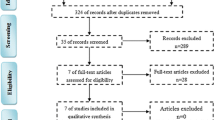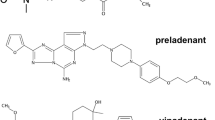Abstract
Long-term disability in Parkinson’s disease (PD) is related to progression of the underlying disease and the emergence of complications of chronic levodopa therapy. There is a need for new medications that can slow the underlying progression of degeneration, improve PD symptoms in early disease without inducing dyskinesia, and improve motor fluctuations and ‘off’ time in advanced disease without worsening dyskinesia. Much interest has focused on the development of nondopaminergic therapies, with antagonists of the adenosine A2A receptor emerging as leading candidates. A2A receptors are selectively expressed in the basal ganglia and specific A2A antagonists reverse motor deficits without causing dyskinesia in animal models of PD. The antiparkinsonian potential of A2A receptor blockade has been expanded further by convergent epidemiological and laboratory findings suggesting a possible neuroprotective effect of A2A receptor antagonists in PD. Istradefylline (KW-6002) is the first of several adenosine A2A receptor antagonists in development for PD to advance to phase III clinical trials. Initial studies indicate that in patients with motor fluctuations on levodopa, addition of istradefylline reduces ‘off’ time. Additional studies are necessary to evaluate the benefit of istradefylline as monotherapy in early disease, its effect on the development of dyskinesia, and its effect on disease progression.


Similar content being viewed by others
References
Ahlskog JE, Muenter MD. Frequency of levodopa-related dyskinesias and motor fluctuations as estimated from the cumulative literature. Mov Disord 2001; 16: 448–58
Rascol O, Brooks DJ, Korczyn AD, et al. A five-year study of the incidence of dyskinesia in patients with early Parkinson’s disease who were treated with ropinirole or levodopa. 056 Study Group. N Engl J Med 2000; 342: 1484–91
Kase H, Richardson P, Jenner P, editors. Adenosine receptors and Parkinson’s disease. San Diego (CA): Academic Press, 2000
Xu K, Bastia E, Schwarzschild M. Therapeutic potential of adenosine A2A receptor antagonists in Parkinson’s disease. Pharmacol Ther 2005; 105: 267–310
Cunha RA. Adenosine as a neuromodulator and as a homeostatic regulator in the nervous system: different roles, different sources and different receptors. Neurochem Int 2002; 38: 107–25
Tohyama M, Takatsuji K. Atlas of neuroactive substances and their receptors in the rat. Oxford: Oxford University Press, 1998
Bara-Jimenez W, Sherzai A, Dimitrova T, et al. Adenosine A2A receptor antagonist treatment of Parkinson’s disease. Neurology 2003; 61: 293–6
Hauser RA, Hubble JP, Truong DD, et al. Randomized trial of the adenosine A2A antagonist istradefylline in advanced PD. Neurology 2003; 61: 297–303
Stacy MA, the US-005 and US-006 Investigator Group. Istradefylline (KW-6002) as adjunctive therapy in patients with advanced Parkinson’s disease: a positive safety profile with supporting efficacy [abstract]. Mov Disord 2004; 19Suppl. 9: S215–S6
Albin RL, Young AB, Penney JB. The functional anatomy of basal ganglia disorders. Trends Neurosci 1989; 12: 366–75
Kase H, Aoyama S, Ichimura M, et al. Progress in pursuit of therapeutic A2A antagonists: the adenosine A2A receptor selective antagonist KW6002: research and development toward a novel nondopaminergic therapy for Parkinson’s disease. Neurology 2003; 61 (11 Suppl. 6): S97–S100
Wichmann T, DeLong MR. Functional neuroanatomy of the basal ganglia in Parkinson’s disease. Adv Neurol 2003; 91: 9–18
Fink JS, Weaver DR, Rivkees SA, et al. Molecular cloning of the rat A2 adenosine receptor: selective co-expression with D2 dopamine receptors in rat striatum. Brain Res Mol Brain Res 1992; 14: 186–95
Schiffmann SN, Jacobs O, Vanderhaeghen JJ. Striatal restricted adenosine A2 receptor (RDC8) is expressed by enkephalin but not by substance P neurons: an in situ hybridization histochemistry study. J Neurochem 1991; 57: 1062–7
Ochi M, Koga K, Kurokawa M, et al. Systemic administration of adenosine A2A receptor antagonist reverses increased GABA release in the globus pallidus of unilateral 6-hydroxydopamine-lesioned rats: a microdialysis study. Neuroscience 2000; 100: 53–62
Bastia E, Xu Y-H, Scibelli AC, et al. A crucial role for forebrain adenosine A2A receptors in amphetamine sensitization. Neuropsychopharmacology 2005 May; 30(5): 891–900
Pinna A, Di Chiara G, Wardas J, et al. Blockade of A2a adenosine receptors positively modulates turning behaviour and c-Fos expression induced by D1 agonists in dopaminedenervated rats. Eur J Neurosci 1996; 8: 1176–81
Fenu S, Pinna A, Ongini E, et al. Adenosine A2A receptor antagonism potentiates L-DOPA-induced turning behaviour and c-fos expression in 6-hydroxydopamine-lesioned rats. Eur J Pharmacol 1997; 321: 143–7
Koga K, Kurokawa M, Ochi M, et al. Adenosine A2A receptor antagonists KF17837 and KW-6002 potentiate rotation induced by dopaminergic drugs in hemi-Parkinsonian rats. Eur J Pharmacol 2000; 408: 249–55
Stromberg I, Popoli P, Muller CE, et al. Electrophysiological and behavioural evidence for an antagonistic modulatory role of adenosine A2A receptors in dopamine D2 receptor regulation in the rat dopamine-denervated striatum. Eur J Neurosci 2000; 12: 4033–7
Pinna A, Fenu S, Morelli M. Motor stimulant effects of the adenosine A2A receptor antagonist SCH 58261 do not develop tolerance after repeated treatments in 6-hydroxydopaminelesioned rats. Synapse 2001; 39: 233–8
Kanda T, Shiozaki S, Shimada J, et al. KF17837: a novel selective adenosine A2A receptor antagonist with anticataleptic activity. Eur J Pharmacol 1994; 256: 263–8
Hauber W, Nagel J, Sauer R, et al. Motor effects induced by a blockade of adenosine A2A receptors in the caudate-putamen. Neuroreport 1998; 9: 1803–6
Shiozaki S, Ichikawa S, Nakamura J, et al. Actions of adenosine A2A receptor antagonist KW-6002 on drug-induced catalepsy and hypokinesia caused by reserpine or MPTP. Psychopharmacology 1999; 147: 90–5
Wardas J, Konieczny J, Lorenc-Koci E. SCH 58261, an A2A adenosine receptor antagonist, counteracts parkinsonian-like muscle rigidity in rats. Synapse 2001; 41: 160–71
Correa M, Wisniecki A, Betz A, et al. The adenosine A2A antagonist KF17837 reverses the locomotor suppression and tremulous jaw movements induced by haloperidol in rats: possible relevance to parkinsonism. Behav Brain Res 2004; 148: 47–54
Simola N, Fenu S, Baraldi PG, et al. Blockade of adenosine A2A receptors antagonizes parkinsonian tremor in the rat tacrine model by an action on specific striatal regions. Exp Neurol 2004; 189: 182–8
Kanda T, Jackson MJ, Smith LA, et al. Adenosine A2A antagonist: a novel antiparkinsonian agent that does not provoke dyskinesia in parkinsonian monkeys. Ann Neurol 1998; 43: 507–13
Grondin R, Bedard PJ, Hadj Tahar A, et al. Antiparkinsonian effect of a new selective adenosine A2A receptor antagonist in MPTP-treated monkeys. Neurology 1999; 52: 1673–7
Kanda T, Jackson MJ, Smith LA, et al. Combined use of the adenosine A2A antagonist KW-6002 with L-DOPA or with selective Dl or D2 dopamine agonists increases antiparkinsonian activity but not dyskinesia in MPTP-treated monkeys. Exp Neurol 2000; 162: 321–7
Hernan MA, Takkouche B, Caamano-Isorna F, et al. A meta-analysis of coffee drinking, cigarette smoking, and the risk of Parkinson’s disease. Ann Neurol 2002; 52: 276–84
Ross GW, Abbott RD, Petrovitch H, et al. Association of coffee and caffeine intake with the risk of Parkinson disease. JAMA 2000; 283: 2674–9
Ascherio A, Zhang SM, Hernan MA, et al. Prospective study of caffeine consumption and risk of Parkinson’s disease in men and women. Ann Neurol 2001; 50: 56–63
Benedetti MD, Bower JH, Maraganore DM, et al. Smoking, alcohol, and coffee consumption preceding Parkinson’s disease: a case-control study. Neurology 2000; 55: 1350–8
Ascherio A, Chen H, Schwarzschild MA, et al. Caffeine, postmenopausal estrogen, and risk of Parkinson’s disease. Neurology 2003; 60: 790–5
Ascherio A, Weisskopf MG, O’Reilly EJ. Coffee consumption, gender, and Parkinson’s disease mortality in the cancer prevention study II cohort: the modifying effects of estrogen. Am J Epidemiol 2004; 160: 977–84
Chen J-F, Xu K, Petzer JP, et al. Neuroprotection by caffeine and A2A adenosine receptor inactivation in a model of Parkinson’s disease. J Neurosci 2001; 21: RC143, 1–6
Xu K, Xu Y-H, Chen J-F, et al. Caffeine’s neuroprotection against 1-methyl-4-phenyl-1,2,3,6-tetrahydropyridine toxicity shows no tolerance to chronic caffeine administration in mice. Neurosci Lett 2002; 322: 13–6
Joghataie MT, Roghani M, Negahdar F, et al. Protective effect of caffeine against neurodegeneration in a model of Parkinson’s disease in rat: behavioral and histochemical evidence. Parkinsonism Relat Disord 2004; 10: 465–8
Oztas E, Kalda A, Xu K, et al. Caffeine attenuates MPTP-induced loss of dopaminergic neurons in substantia nigra in mice. Program No. 487.6. Washington, DC: Society for Neuroscience, 2002
Ikeda K, Kurokawa M, Aoyama S, et al. Neuroprotection by adenosine A2A receptor blockade in experimental models of Parkinson’s disease. J Neurochem 2002; 80: 262–70
Pierri M, Vaudano E, Sager T, et al. KW-6002 protects from MPTP induced dopaminergic toxicity in the mouse. Neuropharmacology 2005 Mar; 48(4): 517–24
Ledent C, Vaugeois JM, Schiffmann SN, et al. Aggressiveness, hypoalgesia and high blood pressure in mice lacking the adenosine A2a receptor. Nature 1997; 388: 674–8
Chen J-F, Huang Z, Ma J, et al. A2A adenosine receptor deficiency attenuates brain injury induced by transient focal ischemia in mice. J Neurosci 1999; 19: 9192–200
Fredduzzi S, Moratalla R, Monopoli A, et al. Persistent behavioral sensitization to chronic L-DOPA requires A2A adenosine receptors. J Neurosci 2002; 22: 1054–62
Bibbiani F, Oh JD, Petzer JP, et al. A2A antagonist prevents dopamine agonist-induced motor complications in animal models of Parkinson’s disease. Exp Neurol 2003; 184: 285–94
Bové J, Marin C, Bonastre M, et al. Adenosine A2A antagonism reverses levodopa-induced motor alterations in hemiparkinsonian rats. Synapse 2002; 46: 251–7
Lundblad M, Vaudano E, Cenci MA. Cellular and behavioural effects of the adenosine A2a receptor antagonist KW-6002 in a rat model of L-DOPA-induced dyskinesia. J Neurochem 2003; 84: 1398–410
Hauser RA, Friedlander J, Zesiewicz TA, et al. A home diary to assess functional status in Parkinson’s disease patients with motor fluctuations and dyskinesia. J Clin Neuropharmacol 2000; 23: 75–81
LeWitt PA, US-005/US-006 Clinical Investigator Group. ‘Off’ time reduction from adjunctive use of istradefylline (KW-6002) in levodopa-treated patients with advanced Parkinson’s disease [abstract]. Mov Disord 2004; 19Suppl. 9: S222
Acknowledgements
Dr Hauser has received consulting and speaking fees from Kyowa. Dr Schwarzschild has nothing to disclose.
This study was supported by DoD grant W81XWH and the Paul Beeson Faculty Scholars Program.
We thank Drs Kui Xu and Elena Bastia for their helpful commentary.
Author information
Authors and Affiliations
Corresponding author
Rights and permissions
About this article
Cite this article
Hauser, R.A., Schwarzschild, M.A. Adenosine A2A Receptor Antagonists for Parkinson’s Disease. Drugs Aging 22, 471–482 (2005). https://doi.org/10.2165/00002512-200522060-00002
Published:
Issue Date:
DOI: https://doi.org/10.2165/00002512-200522060-00002




